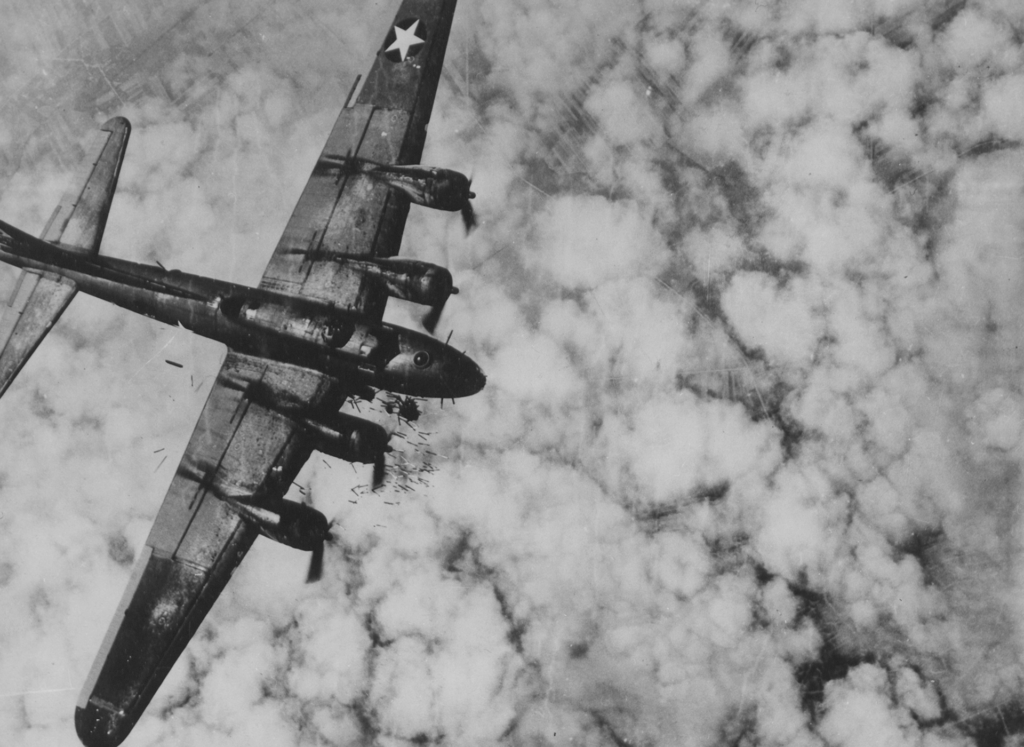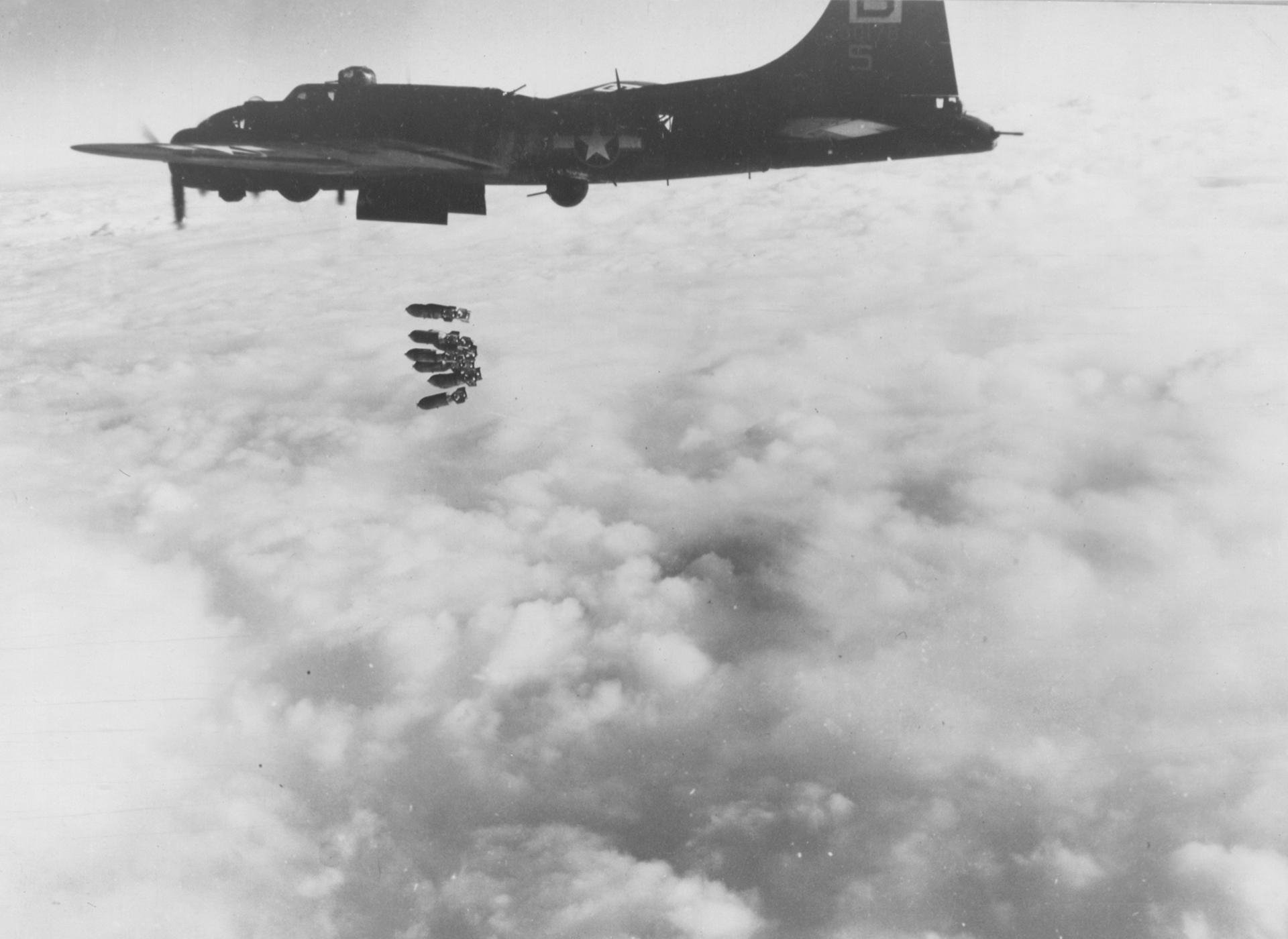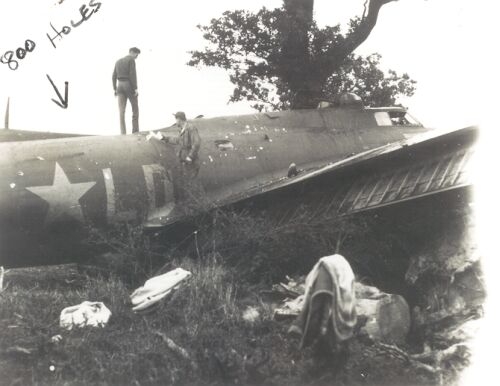
Boeing B-17 “Flying Fortress” of the 8th Air Force releasing load of incendiary bombs over Oscherleben, Germany. Printed December 1943. Source: National Archives at College Park
The US Army Air Forces (USAAF) entered World War II with the newly framed doctrine of daylight precision bombing. Developed at the Air Corps Tactical School at Maxwell Field, Alabama, the doctrine recognized that modern warfare increasingly leveraged a nation’s industrial capacities and its associated workforce. Airpower advocates believed attacking enemy infrastructure and industrial capabilities precluded a repeat of the World War I stalemate. As World War II began, the Americans and the British embraced the idea of strategic bombardment not only to reduce an enemy’s ability to prosecute war, but also to provide relatively quick victory at less expense. However, in October 1943, this theory was severely tested.
While the idea of a bombing campaign sounded attractive, there was very little precedent for such an effort. During the interwar years, aviation technology grew by leaps and bounds, but, unfortunately for the USAAF, so too did aerial defense. The introduction of radar, high velocity weapons, and wireless communication saw to the development of Integrated Aerial Defenses (IAD), providing a significant counter to strategic bombing execution. As a result, when the Allied air forces began their campaign in the European theater, the learning curve was steep and as costly as it was bloody. During the first half of 1943, bomber losses were high, and over the course of a few days in early October, American losses were so great that it caused a pause to the entire effort. In what became known as “Black Week,” the American bomber effort found itself at a crossroads.
B-17 Flying Fortress & Eighth Air Force
Initially, the USAAF believed that its new Boeing B-17 Flying Fortress was aptly named. Bristling with up to 11 machine guns, planners thought B-17s could defend themselves as they flew over enemy territory, bombing designated industrial targets. Accompanied by the Consolidated B-24 Liberator that carried much of the same defensive armament, the USAAF did not see the need for escort fighters to shepherd the bombers to their targets. Flying in large formations, bomb groups thought there was “safety in numbers” with the four-engine planes defending themselves against enemy fighters. Along with this assumption, engineering challenges of the interwar years underpinned the doctrine. Aircraft designers believed that building an escort fighter that could fly as far as a bomber and pack sufficient firepower while having the required maneuverability to engage enemy interceptors was a technical impossibility. Given these assumptions, during the opening phases of the strategic campaign, USAAF bombers flew without fighter escorts while operating deep into enemy territory.
Spearheading the American effort was the Eighth US Air Force flying out of bases in the East Anglia region of England. Initial operations were against targets in France and slowly extended to the Low Countries and Greater Germany. Initially hitting targets such as German U-boat pens on the coast of France along with ports and airfields, the USAAF bomber crews received their baptism of fire. However, as the Americans flew combat operations, they began to see faults in their prewar doctrine. One of the these was a failure to appreciate IAD effectiveness, which became apparent when the loss of bombers and crews started to climb. In late 1943, the average life expectancy of a B-17 was a mere 11 missions; a similar statistic applied to the crews themselves. With the fierce enemy fighter threat growing in the first half of 1943, American P-47 Thunderbolts and Royal Air Force Spitfires provided only short-range escort: When these fighters reached their operational range near the western border of Germany, they peeled off and returned to base. After their departure, the American bombers were then at the mercy of the German Luftwaffe.
Because of the short range of the fighter support, bomber losses and casualty rates continued to rise. Despite the losses, the USAAF continued to fly deeper into German territory. On October 8, the Eighth Air Force executed a three-pronged attack on German U-boat yards at Bremen and aircraft factories at Vegesack. Heading for Bremen, the 1st Air Division’s B-17s flew a direct route over Holland while the 3rd Air Division’s Fortresses came in from the North Sea. The third element, targeting Vegesack, also took a North Sea route and consisted of B-24s from the 2nd Air Division. Even before the P-47 escort returned to base, Luftwaffe Fw 190 and Me 109 fighters pounced upon the 1st Division. Enemy fighters flew within 100 yards of the Fortresses, delivering withering fire into the formation. One group from the division lost seven of its 18 bombers.
The 3rd Division also suffered but, in this case, from accurate German Fliegerabwehrkanone (flak) over the target area. Ground-based antiaircraft fire damaged two-thirds of the B-17s that made it over Bremen. After dropping its bombs, one Fortress from the 100th Bomb Group christened Just A Snapp’n flew back with only three engines, much of the control surfaces shot away, and more than 700 holes in the rear fuselage alone. The plane crash-landed in a field and stopped after hitting a tree. Maintenance personnel eventually found over 800 holes throughout the entire airframe before they got tired of counting! While 357 bombers took part in the raid, 10 percent of those sortied fell at the hands of the Luftwaffe.
Despite these heavy losses, the next day the Eighth Air Force was again over Germany, hitting additional targets and flying deeper into continental Europe. This time, the Americans sent 370 bombers divided into four separate formations. Planes from the 41st and 1st Bomb Wings of the 1st Air Division set out to hit the Arado aircraft production factory in Anklam, Germany north of Berlin near the Baltic coast. Primarily a diversion from the other three efforts, the Anklam raid was intended to draw enemy fighters north. In the meantime, the 4th and 13th Bomb Wings from the 3rd Air Division set out for the Focke-Wulf aircraft plant at Marienburg. This was the same plant targeted weeks earlier in a raid led by Brigadier General Curtis LeMay during the infamous “shuttle raid” of August 17. The third effort from the 40th and 45th Bomb Wings of the 1st Division set out to strike the ports and docks at Gdynia near the Polish border. Finally, the fourth element consisted of B-24s from the 2nd Bomb Wing targeting U-boat yards at Danzig.
More than 200 bombers successfully hit Anklam without incident, but during the return home, the formation was ferociously attacked by German fighters. While the 41st Bomb Wing avoided any losses, the 1st suffered terribly, losing 20 aircraft with other bombers receiving heavy damage. Attacking formations included fighters using air-to-air rockets lobbed at ranges of more than 1,000 yards. One projectile hit a B-17 with the 351st Bomb Group and lodged itself into the plane’s wing. Unable to shake it loose, the crew landed with the missile still embedded!
Ninety-six planes from the 3rd Air Division struck the Marienburg target and successfully hit the aircraft plant from a medium altitude of 13,000 feet. Losing only two aircraft, the bombers placed 83 percent of their bombs within 2,000 ft of the aim point. However, the 1st Air Division raids over Gdynia and Danzig were much less effective as German smokescreens thwarted aiming efforts. During these missions against the two cities, the division lost eight bombers for relatively little gain. In all, the raids of October 9 resulted in the loss of some 30 planes (approximately 9 percent of those sortied), with heavy damage inflicted on dozens more. More losses were yet to come.
Raid on Munster
On October 10, the Eighth Air Force targeted the town of Munster, which housed a rail line feeding into the industrial Ruhr Valley. Leading the raid was the 3rd Division’s 13th Bomb Wing with P-47 fighter escort supposedly available for much of the planned route. However, a navigation error led to the fighter group’s late rendezvous. When the Thunderbolts finally did arrive, their stay was short; low on fuel they had to return to base. With no fighters to help them, the B-17s were quickly mauled by German fighters. Two hundred Luftwaffe single- and twin-engine planes assaulted the lead bomber formation in what was described in the official report as “the most vilent [sic] and concentrated attack yet made on this division by enemy aircraft.”
At this time of the war, German defenders often paralleled the bomber formation’s trek remaining just out of machine gun range and traveling in packs of 20 to 40 aircraft. The Luftwaffe fighters would then peel away from their own formation, approach the bombers in pairs, and strike at the Americans with frontal attacks. A rotte (two aircraft) or schwarm (four aircraft) of fighters might come as close as 50 to 75 yards before diving away. Bombers in the lowest formations were targeted first as the Germans worked their way up the formation. On this day, the 100th Bomb Group was in the low position and was the first to suffer. After only a few minutes, the 100th’s formation was broken in half, with the Germans then picking off the group’s individual bombers. Of the 13 planes from the 100th that took off for the mission, only one made it to the initial point (IP) of the bomb run. The sole surviving plane, Royal Flush, flown by Lieutenant Robert Rosenthal of the 418th Bomb Squadron, completed the bomb run. However, the plane had two engines shot out, both waist gunners wounded, the oxygen and communications systems damaged, and a large hole ripped in the plane’s right wing. When the plane finally landed at its base at Thorpe Abbotts, one of the crew remarked, “I’m through flying in these things. That’s enough!” Losing 12 out of 13 planes, the nearly complete loss of the squadron’s complement in only one mission quickly became legend in the Eighth Air Force. For the rest of the war, the 100th Bomb Group was considered a “jinxed” unit.
In addition to the single-engine fighters’ cannon and machine gun fire, twin-engine Me 110s and 410s continued to launch aerial rockets at the bombers. Rockets had the potential to knock a bomber out of the air and seriously disrupt large bomber formations. As the 100th was decimated, the high and medium groups were initially spared. Keeping formation, they headed for the IP in preparation for their bomb runs. However, German fighters turned their attention on the two higher groups. After the bombers passed the IP, the Luftwaffe aerial attacks dissipated but were soon replaced by heavy German flak. While the German fighters avoided the flak box and the deadly ground fire, the bombers had no choice but to fly through it. Undaunted, the bombers continued their six-minute bomb run and dropped their ordnance. After clearing the target and flak field to return home, they again were met by German fighters.
These other groups from the 3rd Air Division also suffered. Almost half of the 390th Bomb Group’s formation of 18 planes was shot down. Of the 95th Bomb Group’s original complement of 19, only 14 remained. And the dangers for the surviving bombers did not necessarily end after leaving enemy airspace. Low level fog and mist made landing difficult for planes limping home and looking for a place to set down. The 3rd Division alone lost 25 of its 50 planes on the mission. Of the 138 planes taking part in the raid, 30 were lost. This equated to a 20 percent attrition rate, which was unsustainably high.
‘Black Thursday’: The Second Schweinfurt Raid
Despite the carnage of the 10th, four days later, the Eighth Air Force attacked the German ball bearing factories at Schweinfurt. Targeted earlier in August with mixed results, a second raid was set for October 14 by 291 B-17s launched in two separate waves. One hundred and forty-nine bombers came from the 1st Air Division with 142 more from the 3rd. The two units flew line-abreast approximately 30 miles apart into central Germany. With fighter escort up to the city of Aachen, the mission proceeded unmolested until the P-47s peeled away for home. German radar had picked up the formation as they formed over England and tracked them enroute. After the protective escort was gone, the Luftwaffe quickly pounced. Using the same tactics as before, heavy cannons, machine guns, and rockets from pairs of German fighters assaulted the bombers. Wave after wave of fighters targeted the lead bombers to disrupt the larger formation. As planes fell out of formation, crewmen claimed they could mark their trek from the smoke billowing from downed B-17s.
By the time the 40th Bomb Group reached the target, it had already lost seven of its 49 planes with others seriously damaged. The number lost climbed to 29. Despite the beating they had taken, 228 B-17s made it to the target and dropped their bombs accurately. Of the 1,122 high-explosive bombs dropped, 143 fell within the factory area, hitting 88 standing structures. Despite the mauling, the 40th placed 53 percent of their bombs within 1,000 feet of the aim point. While accurate, the price was steep. In all, the Eighth Air Force lost 60 B-17s out of a force of 229, with five more crash landing in England. Twelve more bombers sustained major damage and had to be written off, with another 121 requiring further repair. More than 600 men were missing or dead with another 43 wounded. While air planners expected a 10 percent loss rate for the mission, the actual figure was double that. Given those losses, it was time to take stock. Despite the accurate drops, one thing had become abundantly clear: deep penetrations into Germany without fighter escort were unfeasible.
Given the steep losses over this period, it was quickly dubbed “Black Week,” with the second Schweinfurt raid referred to as “Black Thursday.” Morale at the air bases was at an all-time low as empty bunks in the Quonset huts stood testament to the losses. During the course of the week, the Eighth Air Force had lost 148 bombers, nearly 13 percent of its attacking aircraft, and approximately 1,500 aircrew. Despite the ample armament of the bombers, it was clear that long-range fighter escort was a requirement. The USAAF’s prewar doctrine proved deficient in the face of such stout German defenses. For the remainder of the year, the Eighth Air Force struck targets in France, coastal areas, or wherever fighter escort could cover them. For the time being, the USAAF had to suspend deep strikes and long-range operations.
However, unbeknownst to most of the men, help was on the horizon. In December 1943, the first P-51 Mustang unit arrived at Boxted, England, with more to follow. Capable of operating deep into occupied territory, heavily armed, and extremely maneuverable, the new fighter was a game-changer. As the P-51 arrived in theater, the Eighth Air Force also received a new commander. In January 1944, Lieutenant General Jimmy Doolittle, who led the 1942 raid on Tokyo, took charge and changed the very nature of the air war. Leveraging the new airframe, he also updated fighter tactics, and over the next few months eventually turned the tide of air war.





